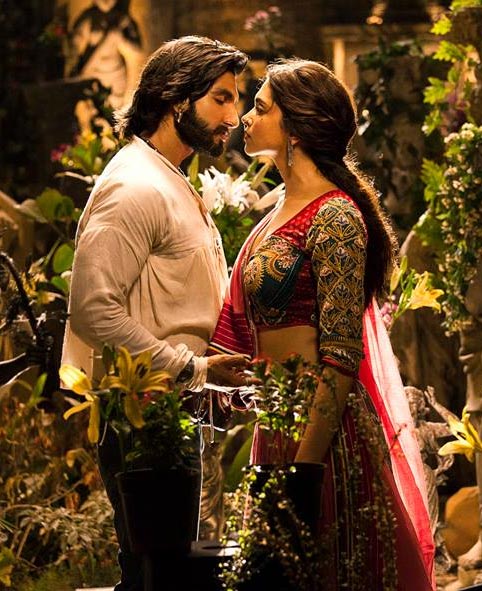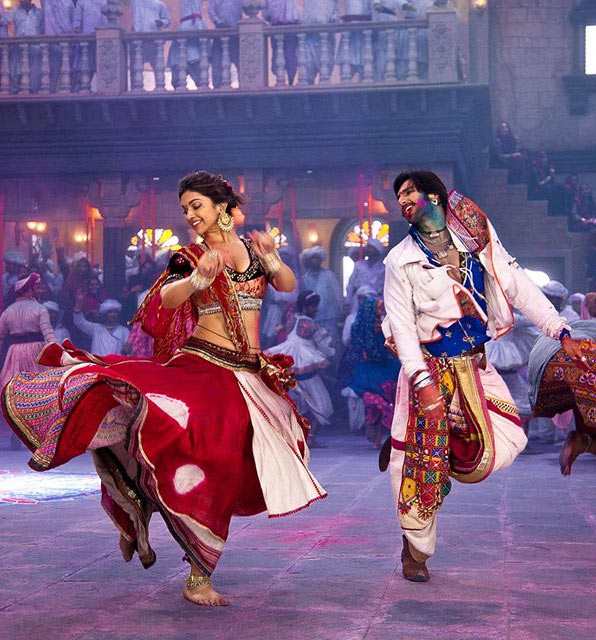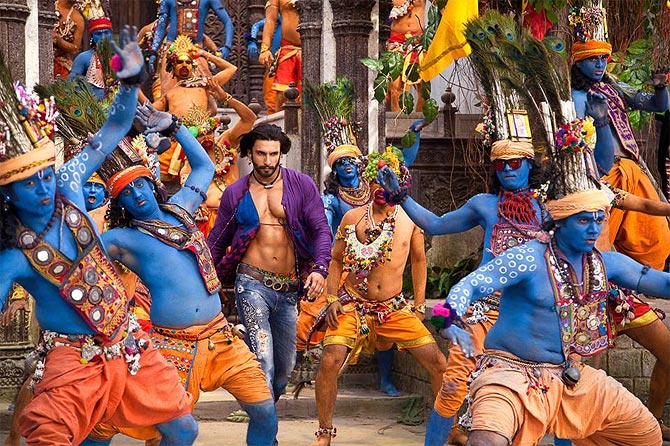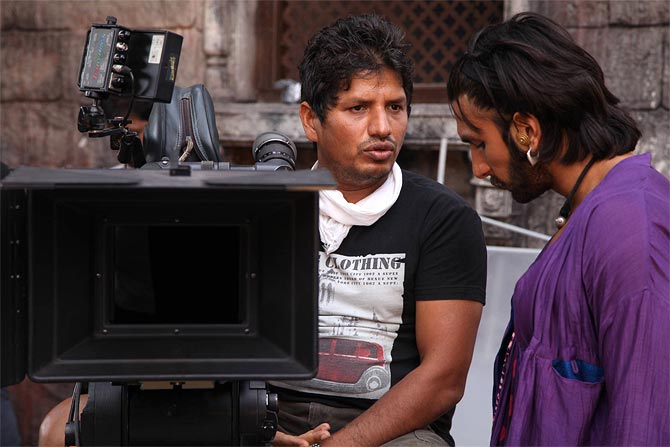Shobha Warrier in Chennai
Ravi Varman, the acclaimed cinematographer, does not believe in method in his work. He believes that cinematography is creativity and it has to flow incessantly.
He won the best cinematography award at the 23rd International Film Festival in France for Jayaraj's Malayalam film, Santham.
Several landmark films later, the cinematographer remains the same, calling his work just a happening in the long journey that he undertakes, where he sees only what is ahead of him.
He doesn't believe in dwelling on the past or in planning for the future. “My life is a journey and it just flows like a river,” he says philosophically.
His last Hindi film, Barfi, was much appreciated and with Ram Leela, the appreciation has doubled.
In this interview, he talks about some of the interesting moments shooting Ram Leela
Your work in Ram Leela has been unanimously hailed as outstanding. Are you flooded with congratulatory messages?
It is true that I am getting a lot of messages appreciating my work in Ram Leela. But such things have stopped exciting me.
It is like the temple festivals that happen in villages; for one week, there will be a lot of excitement and after that, everybody will forget about it.
One thing that has made me happy is that at least 15-20 crore people watch films and some of them remember my name because of my work.
They are unknown people and they know me only through my work. That is the most satisfying moment for me; nothing else.
It is true that people associated with the industry also appreciate your work if it's good. Though that makes me happy, I prefer to move on, and I have moved on from Ram Leela.
Ram Leela happened when I was working for Barfi and now, after Ram Leela, I am working with the Barfi team for their next film Jagga Jasoos.
That is why I said my life as a cinematographer is a journey and it can only move forward from one film to another.
'I don't plan how a film should be and how it should look'
Image: Ravi Varman and Sanjay Leela Bhansali on the sets Ram LeelaRam Leela is set in a small colourful village in Gujarat and it has a riot of colours. Did Sanjay Leela Bhansali (the director) tell you about the kind of look he wanted for the film?
No. That is the greatness of the director. After he saw the first shot of the film which was the introduction of Supriya Pathak, he said, I am going to work with a painter!
That was all that he said.
I felt at that time was he not praising me a bit too much? Then I thought, perhaps he said so to extract more work from me (laughs). Soon, I understood he was very genuine in his comments.
Did you go to Gujarat to find out about the culture, looks, etc so that you can plan how the movie should look?
The truth is I don't plan how a film should be and how it should look. What I feel when I am there on the sets and what my mind tells me after hearing the story is what I capture on the camera.
I have been to Gujarat, Rajasthan, etc several times, and I have noticed that you see many colours, art work and also mirrors in their dress.
It is not monochromatic and extremely artistic unlike what we see in this part of India. So, for me, each and every aspect of Gujarat was fascinating and interesting.
'I could achieve 80 per cent of what I had in my mind for Ram Leela'
Image: Ranveer Singh and Deepika Padukone in Ram LeelaLike you spoke about how you felt about Kolkata when you went to shoot Barfi for the first time in the city...
Exactly. So, the place, people and their culture was so inspiring for me. More than anything, the film is inspired by Romeo and Juliet, which I have read many times. Each time I read it, I wondered whether I would be able to make a film like this.
The story of Ram Leela is both romantic and violent. It is happening in a creative, artistic world. I referred to hundreds of classic paintings, masterpieces so that I could shoot the film like a series of paintings.
I wanted every frame to be magical, like there is magic in morning sunlight caressing you when you open the window. All the paintings that have inspired me in my life got reflected in the film.
There is love and also guns and violence in abundance in Ram Leela. How did you differentiate the two extreme emotions when you shot the film?
Only when extreme emotions are there, you can show the contradiction. Like there has to be black to compensate white, hatred or violence has to be there to enhance the beauty of love.
Love in Ram Leela got elevated only because of the kind of violence that is there in the film.
If you notice, the entire film has golden yellow colour dominating. Every shade has an emotion associated with it like sadness is associated with black, celebration with white, and violence with red.
But golden yellow can connect with both love and violence. Golden yellow softens violence and enhances love. Look at the morning light and you feel fresh. You see golden yellow in all the frames of the film.
Was it Sanjay Leela Bhansali's suggestion?
No, he told me to do whatever I want, to experiment. He gave me total freedom.
When you hear a story, you get inspired to shoot the story in a particular way.
In the case of Ram Leela, I could achieve 80 per cent of what I had in my mind.
'The most challenging part was having so many people in all the frames'
Image: Ranveer Singh in Ram LeelaWhat was the most challenging aspect of shooting this film?
The most challenging part was having so many people in all the frames. It is easy to shoot close shots or long shots with a few people but here, every shot is like a huge painting on a big canvas with many images in it.
For a cinematographer, it is difficult to maintain consistency in lighting when you have such a big canvas in every shot.
It was very stressful for me to maintain the quality. I didn't feel this kind of stress in any other film. Every morning I got up feeling so stressed and when going to bed that day, I used to feel relieved that I could manage.
This continued for all the 200 days I worked for Ram Leela! After I finished the entire lab work, I came to Chennai without talking to him (Sanjay Leela Bhansali).
After he saw the film, I called and asked him, “Are you happy, Sir?” He told me, “You gave me 200% more than what I had in my mind.”
That, I feel is my success; I could translate a director's vision onto the screen.
Any particular shot of yours that impressed you after you saw it later?
There is a beautiful scene in the film in which you see chillies all around and Supriya Pathak talking to her son while walking. You can see sunlight peeping through the window. It was not shot outdoors and the sunlight effect was created indoors!
There is another touching scene where Supriya Pathak sits in front of the mirror dressing up, with light coming from top. That scene was so beautiful that I used to see it again and again.
I must have seen it at least 15 times but every time I see it, I used to see freshness in it. That was one frame in which I could not find any mistake! The entire scene was created artificially and what I had in my mind came exactly on screen, which rarely happens.
The frame was so magical that I feel that it is the best scene I shot in the entire film.
'I feel my best work was in Santham'
Image: Ravi Varman and Ranveer Singh in Ram LeelaAfter watching the riot of colours in Ram Leela, I am reminded of Santham, which you shot in Kerala. White, green and rain were predominant in that film. Do you feel these are the two contrasting films you shot in your career?
I feel my best work was in Santham. When I was shooting it, I didn't have much technical knowledge. There was not much of a budget for the film. I had to shoot the entire film in natural light when it was raining, with whatever light was available.
It was extremely difficult to shoot in such conditions. It was just my second film, but I did it. Today, when I watch Santham, I am surprised by the results. I don’t know how I achieved it.
Kerala and Gujarat offer contrasts. In Kerala there is an abundance of green and women wear white more often. In Gujarat you see such vibrant colours. I feel I am a chameleon shooting in these contrasting conditions.
I see to it that every film looks different. Santham is different from Ram Leela. Dagga Jasoos will look totally different from Barfi and Ram Leela.
I feel like a new cinematographer when I start a new film, having totally forgotten my other works.






Comment
article